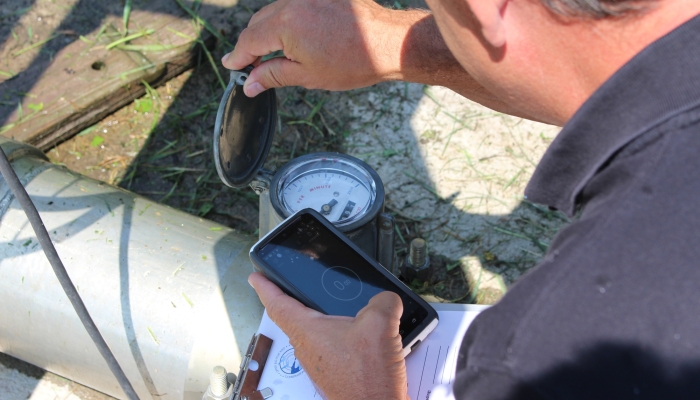Allocation (Potential)
Due to the drought conditions in the Upper Big Blue Natural Resources District area through much of 2022 and 2023, district staff have received many questions about allocation rules for groundwater users. While no allocation rules are currently in effect in the Upper Big Blue NRD, staff wants to ensure that if such rules are implemented, district groundwater users understand how the district would administer an allocation.
The district is well prepared in case of a groundwater shortage. Groundwater allocation rules and regulations were set by the Board of Directors in 1978 and have been updated several times in the past 45 years. Action by the Board of Directors of the NRD is the only way to modify these rules. If you have questions, please contact the NRD at 402-362-6601 or by email at info@upperbigblue.org.
Allocation is defined as the apportioning of groundwater. The district has allocation rules for agricultural and municipal and other groundwater users.
Water Levels in Spring 2024
NRD staff measure observation wells in the spring of each year, allowing the water table to rebound from the previous irrigation season. The wells that are measured are distributed throughout the district to provide an accurate profile of the average groundwater level change. Each well measured is assigned an area of the district based on distances from other measured wells. This method gives the groundwater level change a weighted average.
During March and April 2024, NRD staff measured roughly 500 observation wells throughout the district to determine the average water level change, based on a weighted change from each well. For spring 2024 water level measurements, the NRD has determined that the average groundwater level change shows a decline of 3.08 feet from last spring. The spring 2024 average groundwater level is now 3.6 feet above the “Allocation Trigger.”
Allocation Trigger
The spring 2024 average groundwater level was 3.6 feet above the “Allocation Trigger”. Thus, there are no allocation restrictions for the 2025 irrigation season.
The district’s goal is to hold the average groundwater level at or above the 1978 level (see graph). In 2005, the district average groundwater level reached the “Reporting Trigger”, initiating mandatory reporting of annual groundwater use to the district and certification of irrigated acres. If the district average water level falls below the 1978 level (“Allocation Trigger”), groundwater allocation will go into effect.
Allocation Rules Summary
For full details on the Upper Big Blue NRD’s allocation regulations, see NRD Rule 5.
- If the district groundwater level falls below the 1978 District groundwater level, action by the board to implement allocation rules and regulations would become effective on January 1 of the following year.
- The Board of Directors will set the duration of the groundwater use period and allocation amount by September 1 prior to the start of the initial and each subsequent groundwater use period.
- Current rules allow for the first groundwater use period to be for 36 months; the second groundwater use period, if enacted, would be for 60 months.
- The groundwater allocation for the first groundwater use period (36 months) would be 30 inches per certified groundwater use acre.
- The groundwater allocation for the second groundwater use period (60 months) would be 45 inches per certified groundwater use acre.
- If the district groundwater level, determined for the final year of a groundwater use period, has risen to a level that is more than three (3) feet above the 1978 District groundwater level, implementation of allocation rules and regulations will be suspended. The board may consider suspending allocation for the final year of the current allocation period.
- Transfers: New transfers of groundwater will be prohibited when allocation has been established (some exceptions apply).
- Pooling: Allocation pools allow groundwater users flexibility to use allocation water over multiple fields based on well, owner-operators, or agreement pool. For the specific rules for pooling, see Rule 5, Chapter 12. The NRD will also mail pooling and allocation summary documents to producers in the future.
- Carry Over of Unused Allocation: Remaining allocation during a groundwater use period may be carried over to the next consecutive groundwater use period. The maximum carryover shall not exceed 10 percent of the total allocation for the groundwater use period.
Allocation Rules Specific to Municipal Water Users
- In an allocation period, a municipal user shall limit groundwater withdrawal to an average of 250 gallons per capita served per day plus the allocation amount per certified acre determined by the Board as provided in Rule 5 for one-third (1 /3) of the non-agricultural lands within the municipal jurisdictional limits for the groundwater use period.
- Conservation procedures required: By March 1 after implementation of Rule 5, Chapter 16, the municipal user must have adopted an administrative procedure that allows the municipal user to require water conservation practices and restrict the water use of its customers.
- Groundwater used for fire protection, water and sewage system maintenance and construction and repairs shall not be considered when calculating annual groundwater withdrawal.
- Any well using more than 50 gallons per minute is considered a high capacity well. This includes industrial users.

